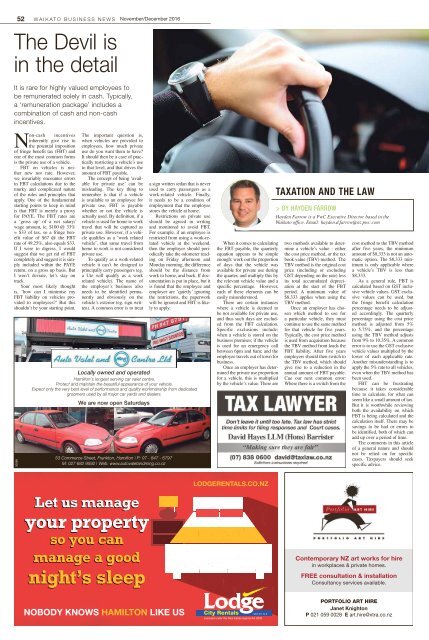Waikato Business News November/December 2016
Waikato Business News has for a quarter of a century been the voice of the region’s business community, a business community with a very real commitment to innovation and an ethos of co-operation.
Waikato Business News has for a quarter of a century been the
voice of the region’s business community, a business community
with a very real commitment to innovation and an ethos of
co-operation.
You also want an ePaper? Increase the reach of your titles
YUMPU automatically turns print PDFs into web optimized ePapers that Google loves.
52 WAIKATO BUSINESS NEWS <strong>November</strong>/<strong>December</strong> <strong>2016</strong><br />
The Devil is<br />
in the detail<br />
It is rare for highly valued employees to<br />
be remunerated solely in cash. Typically,<br />
a ‘remuneration package’ includes a<br />
combination of cash and non-cash<br />
incentives.<br />
Non-cash incentives<br />
inherently give rise to<br />
the potential imposition<br />
of fringe benefit tax (FBT) and<br />
one of the most common forms<br />
is the private use of a vehicle.<br />
FBT on vehicles is neither<br />
new nor rare. However,<br />
we invariably encounter errors<br />
in FBT calculations due to the<br />
murky and complicated nature<br />
of the rules and principles that<br />
apply. One of the fundamental<br />
starting points to keep in mind<br />
is that FBT is merely a proxy<br />
for PAYE. The FBT rates are<br />
a ‘gross up’ of a net salary/<br />
wage amount, ie. $100 @ 33%<br />
= $33 of tax, so a fringe benefit<br />
value of $67 @ the FBT<br />
rate of 49.25%, also equals $33.<br />
If I were to digress, I would<br />
suggest that we get rid of FBT<br />
completely and suggest it is simply<br />
included within the PAYE<br />
return, on a gross up basis. But<br />
I won’t deviate, let’s stay on<br />
track.<br />
Your most likely thought<br />
is, ‘how can I minimise my<br />
FBT liability on vehicles provided<br />
to employees?’ But this<br />
shouldn’t be your starting point.<br />
30098<br />
The important question is,<br />
when vehicles are provided to<br />
employees, how much private<br />
use do you want them to have?<br />
It should then be a case of practically<br />
restricting a vehicle’s use<br />
to that level, and that drives the<br />
amount of FBT payable.<br />
The concept of being ‘available<br />
for private use’ can be<br />
misleading. The key thing to<br />
remember is that if a vehicle<br />
is available to an employee for<br />
private use, FBT is payable<br />
whether or not the vehicle is<br />
actually used. By definition, if a<br />
vehicle is used for home to work<br />
travel that will be captured as<br />
private use. However, if a vehicle<br />
qualifies as a "work related<br />
vehicle", that same travel from<br />
home to work is not considered<br />
private use.<br />
To qualify as a work-related<br />
vehicle it can’t be designed to<br />
principally carry passengers (eg.<br />
a Ute will qualify as a work<br />
related vehicle). The name of<br />
the employer’s business also<br />
needs to be identified permanently<br />
and obviously on the<br />
vehicle’s exterior (eg. sign written).<br />
A common error is to treat<br />
a sign written sedan that is never<br />
used to carry passengers as a<br />
work-related vehicle. Finally,<br />
it needs to be a condition of<br />
employment that the employee<br />
stores the vehicle at home.<br />
Restrictions on private use<br />
should be agreed in writing<br />
and monitored to avoid FBT.<br />
For example, if an employee is<br />
restricted from using a work-related<br />
vehicle at the weekend,<br />
then the employer should periodically<br />
take the odometer reading<br />
on Friday afternoon and<br />
Monday morning, the difference<br />
should be the distance from<br />
work to home, and back. If documentation<br />
is put in place, but it<br />
is found that the employee and<br />
employer are ‘quietly’ ignoring<br />
the restrictions, the paperwork<br />
will be ignored and FBT is likely<br />
to apply.<br />
Locally owned and operated<br />
Hamilton's longest serving car valet centre.<br />
Protect and maintain the beautiful appearance of your vehicle.<br />
Expect only the very best level of performance and quality workmanship from dedicated<br />
groomers used by all major car yards and dealers.<br />
We are now open Saturdays<br />
53 Commerce Street, Frankton, Hamilton | P: 07 - 847 - 6797<br />
M: 027 682 9592 | Web: www.autovaletandming.co.nz<br />
When it comes to calculating<br />
the FBT payable, the quarterly<br />
equation appears to be simple<br />
enough: work out the proportion<br />
of days that the vehicle was<br />
available for private use during<br />
the quarter, and multiply this by<br />
the relevant vehicle value and a<br />
specific percentage. However,<br />
each of these elements can be<br />
easily misunderstood.<br />
There are certain instances<br />
where a vehicle is deemed to<br />
be not available for private use,<br />
and thus such days are excluded<br />
from the FBT calculation.<br />
Specific exclusions include:<br />
when a vehicle is stored on the<br />
business premises; if the vehicle<br />
is used for an emergency call<br />
between 6pm and 6am; and the<br />
employee travels out of town for<br />
business.<br />
Once an employer has determined<br />
the private use proportion<br />
for a vehicle, this is multiplied<br />
by the vehicle’s value. There are<br />
TAXATION AND THE LAW<br />
> BY HAYDEN FARROW<br />
Hayden Farrow is a PwC Executive Director based in the<br />
<strong>Waikato</strong> office. Email: hayden.d.farrow@nz.pwc.com<br />
two methods available to determine<br />
a vehicle’s value - either<br />
the cost price method, or the tax<br />
book value (TBV) method. The<br />
TBV method is the original cost<br />
price (including or excluding<br />
GST depending on the rate) less<br />
its total accumulated depreciation<br />
at the start of the FBT<br />
period. A minimum value of<br />
$8,333 applies when using the<br />
TBV method.<br />
Once an employer has chosen<br />
which method to use for<br />
a particular vehicle, they must<br />
continue to use the same method<br />
for that vehicle for five years.<br />
Typically, the cost price method<br />
is used from acquisition because<br />
the TBV method front loads the<br />
FBT liability. After five years<br />
employers should then switch to<br />
the TBV method, which should<br />
give rise to a reduction in the<br />
annual amount of FBT payable.<br />
Cue our next common error:<br />
Where there is a switch from the<br />
cost method to the TBV method<br />
after five years, the minimum<br />
amount of $8,333 is not an automatic<br />
option. The $8,333 minimum<br />
is only applicable where<br />
a vehicle’s TBV is less than<br />
$8,333.<br />
As a general rule, FBT is<br />
calculated based on GST inclusive<br />
vehicle values. GST exclusive<br />
values can be used, but<br />
the fringe benefit calculation<br />
percentage needs to be adjusted<br />
accordingly. The quarterly<br />
percentage using the cost price<br />
method is adjusted from 5%<br />
to 5.75%, and the percentage<br />
using the TBV method adjusts<br />
from 9% to 10.35%. A common<br />
error is to use the GST exclusive<br />
vehicle values multiplied by the<br />
lower of each applicable rate.<br />
Another misunderstanding is to<br />
apply the 5% rate to all vehicles,<br />
even when the TBV method has<br />
been used.<br />
FBT can be frustrating<br />
because it takes considerable<br />
time to calculate, for what can<br />
seem like a small amount of tax.<br />
But it is worthwhile reviewing<br />
both the availability on which<br />
FBT is being calculated and the<br />
calculation itself. There may be<br />
savings to be had or errors to<br />
be identified, both of which can<br />
add up over a period of time.<br />
The comments in this article<br />
of a general nature and should<br />
not be relied on for specific<br />
cases. Taxpayers should seek<br />
specific advice.<br />
LODGERENTALS.CO.NZ<br />
Contemporary NZ art works for hire<br />
in workplaces & private homes.<br />
FrEE consultation & installation<br />
Consultancy services available.<br />
NOBODY KNOWS HAMILTON LIKE US<br />
Portfolio Art Hire<br />
Janet Knighton<br />
P 021 059 0028 E art.hire@xtra.co.nz


















